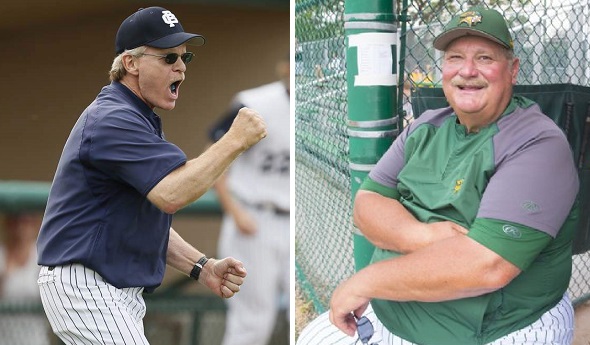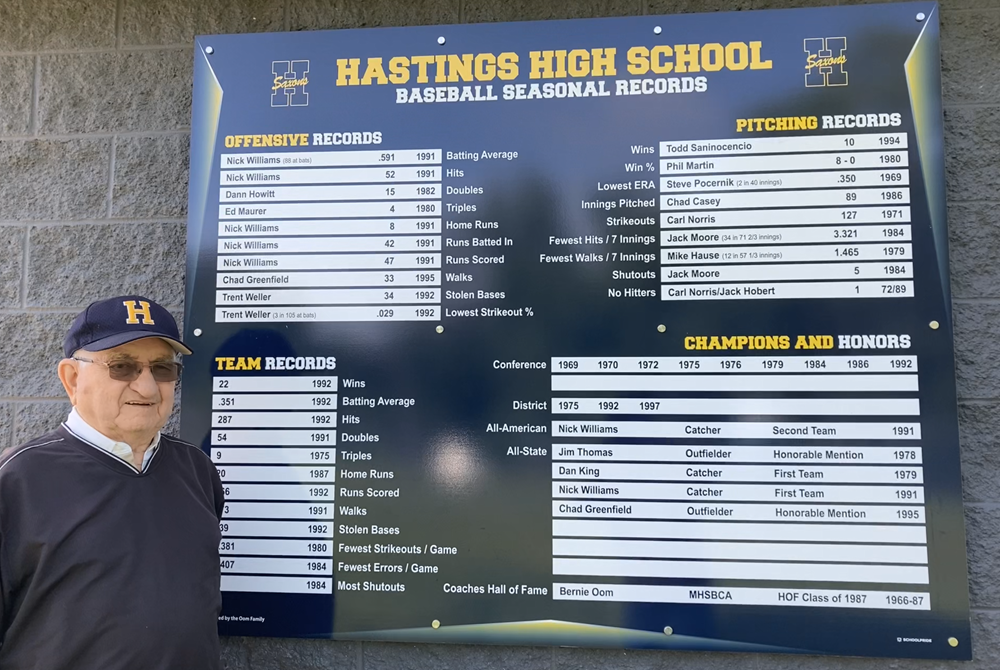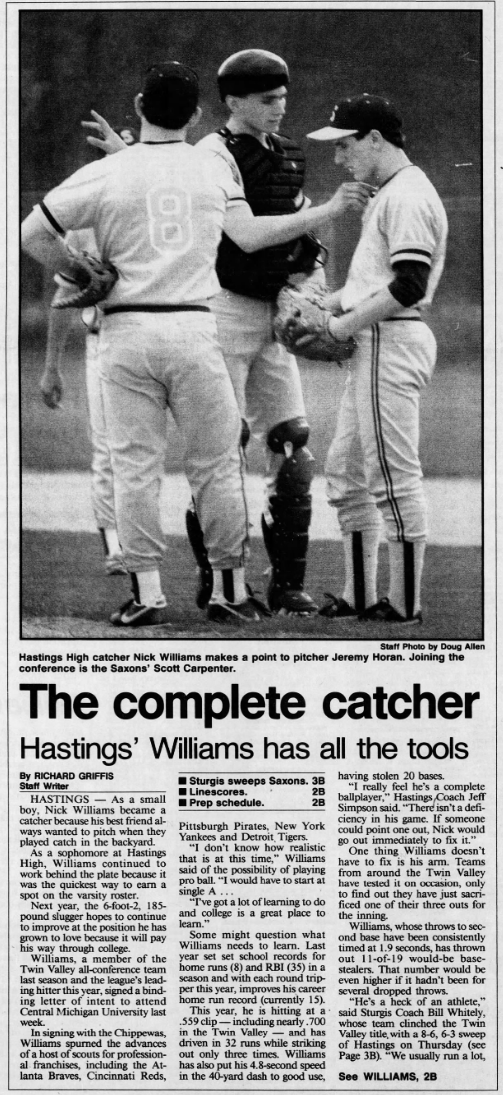
Pointes' Pride Instilled by Longtime Leaders
By
Tom Markowski
Special for Second Half
May 31, 2017
GROSSE POINTE – Neither Frank Sumbera nor Dan Griesbaum were raised in Grosse Pointe.
 But no one, at least at the high school level, has done more to enhance and promote baseball in the Pointes than this long-serving pair.
But no one, at least at the high school level, has done more to enhance and promote baseball in the Pointes than this long-serving pair.
Sumbera, 69, is in his 45th season as coach at Grosse Pointe North and Griesbaum, 64, is in his 34th season at Grosse Pointe South. In this sport the rivalry that exists between Grosse Pointe’s two public high schools is as good as it gets. Sumbera holds the upper hand in MHSAA Finals titles, 2-1, and Griesbaum has the edge in District titles, 23-14.
This last statistic is notable in a sense that the two programs are often paired in the same District, as they are this season. South will host North in a Division 1 District Semifinal at 10 a.m. Saturday.
This season there is an added twist to the much-anticipated community showdown. Grosse Pointe Woods University Liggett, for the first time, will compete in the Division 1 tournament lined up on the other side of the bracket from North and South. University Liggett will play Detroit East English in the other Semifinal at 11:30 a.m. The winners will play for the title approximately 2 p.m.
University Liggett won four MHSAA Finals titles the past six seasons, two in Division 4 and two in Division 3, including last season in the latter. Coach Dan Cimini, knowing he had a strong team returning, petitioned the MHSAA to opt up to Division 1 for this season and 2018.
So far the Knights have proven they can hang at the Division 1 level. They are ranked No. 2 in the latest poll released by the Michigan High School Baseball Coaches Association.
And Cimini’s group received a break in the draw as it won’t have to defeat both North and South to win the District title.
This is Cimini’s 14th season as head coach, and he tips his hat to the job Sumbera and Griesbaum have done in laying the groundwork.
“Frank has been there forever,” Cimini said. “Dan has been there a long time. I feel old, and I’m 48. I’ve coached 22 years. No doubt about it, those guys have set the standard.”
Cimini grew up in Grosse Pointe and competed in the city’s strong Little League program. He played for Griesbaum at South and played four years in college, two at Macomb College and two at University of Detroit Mercy. He was part of the 1987 South team that reached the MHSAA Semifinals for the first time in school history.
Cimini said the quality of baseball has remained strong in the community over the years but noted there have been some changes.
“The Little Leagues are phenomenal,” he said. “The Federation ball is phenomenal. But there aren’t as many kids playing. Now there are seven teams playing in the (Little League) majors. Back when I played there were 13 of 14. I miss those days. If I could take myself back, that’s where I’d go.”
At least in the modern era, one must point to Sumbera as the person most responsible for the quality of baseball being played at the high school level.
Sumbera played three sports at Chesaning High – baseball, basketball and football – and then went on to Central Michigan where he played basketball.
 Upon graduation Sumbera went looking for a job and received a tip from a college roommate. Sumbera was told that Grosse Pointe High would be splitting into two schools, North and South, and that they needed teachers, and, naturally, coaches. North opened for the 1968-69 school year, and Sumbera was hired as an assistant junior varsity football coach. In 1973 he became the assistant varsity baseball coach, and the next season he took over the baseball program.
Upon graduation Sumbera went looking for a job and received a tip from a college roommate. Sumbera was told that Grosse Pointe High would be splitting into two schools, North and South, and that they needed teachers, and, naturally, coaches. North opened for the 1968-69 school year, and Sumbera was hired as an assistant junior varsity football coach. In 1973 he became the assistant varsity baseball coach, and the next season he took over the baseball program.
“We won the District that year,” he said. “I’ll never forget it. We beat (then Detroit, now Warren) DeLaSalle, 2-1, in the final.”
Sumbera has coached some of the best teams in the state. His 2006 Division 1 championship team was 38-1. His 1980 Class A championship team was probably his best. Five players on that team were selected in the Major League Baseball amateur draft including Bill Babcock, one of the top pitchers on that team. Babcock’s son, Luke, will enter the ninth grade next fall is expected to enroll at North and play for Sumbera.
That’s the way it is in the Pointes. This large community that borders Detroit’s eastside is infectious. It’s common for someone who grew up here to remain in the area and raise his or her own family.
“A lot of the kids I coached in the 80s, I’m coaching their sons,” Sumbera said. “They play a lot of baseball here. As they grow through the ranks to high school, (Griesbaum) and I have to make cuts. You might have 250 at the Little League level, and by the time I get them we have like eight.
“The North-South rivalry is as good as any around. I coach football, and it’s intense every year. In baseball it’s as good a rivalry as there is in the state. It’ll be the fifth time we will have played South (this season). In our last doubleheader we won the first, 12-6, and lost the second, 3-2, in eight innings. That was a crusher. It’s big. The kids know it. The families know it. They all go to church together and play against each other during the summer.”
Griesbaum, a graduate of St. Clair Shores South Lake and Central Michigan, where he played baseball, said the level of competition is remarkable especially when one considers the schools do not have open enrollment. The only way one can play for North or South is to live in the school district.
Griesbaum got his start as an assistant under Sumbera (1980-83) before going to South in 1984.
“There’s nothing like a North-South game,” he said. “Our rivalry is one of the best. It’s a baseball community. My 6-year-old grandson plays T-ball. You look at what North and South have accomplished. There’s the (Grosse Pointe) Farms and City (Little League) teams. Then there’s the success of the Redbirds that (former Detroit Tiger) Dave Bergman ran. We run a (Christmas) Holiday hitting camp. We have 75 kids the first day and 75 more the next. It’s for the second through the sixth grades. We want to expose baseball at an early age.”
Some have expressed displeasure that all three Grosse Pointe schools are in the same district. Cimini scoffs at that thought. He said there are many districts throughout the state that have more than their share of quality teams.
The last two seasons North and South were in separate Districts, and they won their respective Districts both years. In 2015, they met in a Division 1 Quarterfinal, and South won. It was the Blue Devils’ seventh trip to the Semifinals, a record (tied with Saline and Grand Ledge) for a public school in Division 1/Class A.
Cimini said he’s looking forward to seeing what his team can do against the established powers.
“I can’t wait,” Sumbera said. “The whole thing is, come June 3 you have to be ready to play.”
 Tom Markowski is a columnist and directs website coverage for the State Champs! Sports Network. He previously covered primarily high school sports for the The Detroit News from 1984-2014, focusing on the Detroit area and contributing to statewide coverage of football and basketball. Contact him at [email protected] with story ideas for Oakland, Macomb and Wayne counties.
Tom Markowski is a columnist and directs website coverage for the State Champs! Sports Network. He previously covered primarily high school sports for the The Detroit News from 1984-2014, focusing on the Detroit area and contributing to statewide coverage of football and basketball. Contact him at [email protected] with story ideas for Oakland, Macomb and Wayne counties.
PHOTOS: (Top) Grosse Pointe South's Dan Griesbaum, left, and North's Frank Sumbera both have led their respective programs for more than three decades (Sumbera for more than four). (Middle) University Liggett coach Dan Cimini played for Griesbaum at South and has built a top program in the community as well. (Photos courtesy of the Griesbaum family, C&G Newspapers and the University Liggett baseball program.

Record Board Celebrates Hastings Record-Setters Over 7 Decades on Diamond
By
Steve Vedder
Special for MHSAA.com
May 29, 2024
Bernie Oom had no intention of letting the past slide into history.
 So the 88-year-old retired longtime Hastings baseball coach embarked on a meticulous two-year labor-of-love project that recognized the Saxons’ record-breaking ballplayers from the last five decades.
So the 88-year-old retired longtime Hastings baseball coach embarked on a meticulous two-year labor-of-love project that recognized the Saxons’ record-breaking ballplayers from the last five decades.
The result is an impressive 63-by-52-inch record board attached to the baseball field's press box located directly behind home plate. The board chronicles a myriad of individual pitching, hitting and team marks derived from Oom's 22 years as coach as well as statistics from his six successors.
Included are records from the top players in Hastings history, including a former Saxon who collected the last hit off hall-of-famer Nolan Ryan, a slugging catcher who was drafted by Seattle and Cincinnati and spent time in the Boston organization, and a Hastings pitcher who owns the oldest mark when he fashioned a 0.35 ERA with just two runs allowed in 40 innings in 1969.
Oom, a member of the Michigan High School Baseball Coaches Association (MHSBCA) Hall of Fame, always kept close track of statistics and records as a coach. Two years ago when his son Wayne began a similar project with the Hastings track program, Oom thought it was time for his former diamond stars to be recognized. While a handful of schools may post scattered records in gymnasiums, it's extremely rare for a school to post records at a baseball field.
"I always liked statistics, and I decided I wanted to keep that kind of stuff up. I'm kind of a stickler for remembering things; details are important to me," said Oom, who compiled a 272-188 record with eight West Central and Twin Valley titles as coach from 1966-87.
"I talked to a lot of my old players, and they thought this was a great idea. But part of the real value is having a ninth grader looking at this and saying, 'I see this, and I want to be up there some day.' I think it will spur things in the program."
In collecting info for the board, Oom went through his 22 seasons of statistics and records, then contacted the six coaches who followed him, including one, Jeff Simpson, who now lives in Arizona. Oom and his son visited local schools such as Grandville and Grand Rapids South Christian for ideas and decided to work with a company called School Pride out of Columbus, Ohio, to produce the board. Oom and the company took two years to get it right, Oom said.
The result are 12 team, 10 offensive and nine individual pitching records as well as a list of the program's all-staters noted on the board.
 Point to any records and the still razor-sharp Oom will have a story about the player or the team that produced the mark. Among them is the 15 doubles clubbed by star Dann Howitt in 1982. Howitt, who played 115 major league games across six seasons with six clubs, has a unique claim to fame as the last player to collect a hit of Nolan Ryan on Sept. 22, 1993. A 46-year-old Ryan, who finished with 324 wins and 5,734 strikeouts, walked the bases loaded against the Seattle Mariners, bringing up Howitt, who promptly drove a Ryan fastball over the left field fence. Ryan, a right-hander, tore a right elbow ligament pitching to the next hitter and exited the game, never to pitch again.
Point to any records and the still razor-sharp Oom will have a story about the player or the team that produced the mark. Among them is the 15 doubles clubbed by star Dann Howitt in 1982. Howitt, who played 115 major league games across six seasons with six clubs, has a unique claim to fame as the last player to collect a hit of Nolan Ryan on Sept. 22, 1993. A 46-year-old Ryan, who finished with 324 wins and 5,734 strikeouts, walked the bases loaded against the Seattle Mariners, bringing up Howitt, who promptly drove a Ryan fastball over the left field fence. Ryan, a right-hander, tore a right elbow ligament pitching to the next hitter and exited the game, never to pitch again.
Oom remembers Howitt more as a line-drive hitter than a power threat. He actually hit more homers as a major leaguer (five) than he did as a Saxon (one in 120 at-bats over two seasons). The doubles record is the only time Howitt appears on the board, despite batting a combined .392 as a junior and senior.
"Teams would pitch around Dann," Oom said of Howitt, whose other claim to fame is backing up stars Mark McGwire, Tino Martinez and Frank Thomas at the major league level.
Among the other records are indicators of arguably the greatest season ever produced by a Hastings hitter. Nick Williams owns program records for batting average (.591), hits (52), homers (8), RBIs (42) and runs (47) all set in 1991. Williams said among his sharpest memories from that spring is struggling through his only hitless game of the season. He went 0-for-3 in the finale to drop below .600 for the only time all spring. At the time, no Michigan high schooler had batted .600 for one season.
"The ball looked big to me all year," said Williams, who was drafted out of high school by the Mariners, out of Central Michigan by the Reds after his junior season and eventually signed with the Red Sox as a free agent. "I had a pretty good high school career, and I was pretty confident as a senior. I had put a lot of work in hitting on a tee in our garage. Then I would play ball all summer. I improved steadily, and I saw the results that summer."
Former Saxons pitcher Steve Pocernik holds the oldest mark on the board after surrendering a meager two runs in 40 innings for a 0.35 ERA in 1969. After 55 years, Pocernik isn't completely sure but thinks the runs came in one game against St. Johns.
"I didn't throw hard, but I had a curve and I could put the ball where I wanted," he said. "(The record) kind of took me by surprise. I think it's super that Bernie had done what he's done. It's a nice thing for the guys who played for him."
Does keeping the record for five and a half decades come as a surprise? Kind of, Pocernik said.
"Yes and no," he said. "Yes in that it's been a lot of years. No because I don't think pitchers today pitch like we did. There are a lot of guys who've come after me."
Another of the Hastings pitching marks is the tiny total of 12 walks in 57 innings by Mike Hause in 1979. That's an average of just 1.4 walks over seven innings. Like Pocernik, Hause said he didn't throw hard. He mixed a curve with a fastball that rode in on righthanded hitters. Speed aside, Hause explains the low number of walks with having a definitive plan as a pitcher. He remembers focusing on throwing first-pitch strikes and then keeping hitters off-balance with an occasional knuckleball.
"I would work on hitting my spot even in the preseason in the gym," he said. "We put up a strike zone mat with holes in it, and I would try to throw the ball through that spot. I didn't throw as hard as some guys, but I threw strikes."
PHOTOS (Top) Retired Hastings baseball coach Bernie Oom stands with the record board he’s created that is displayed at the school’s diamond. (Middle) A Battle Creek Enquirer story from 1991 discusses Nick Williams' accomplishments. (Photo by Steve Vedder.)

